Please Take Note: This is a review of the final game, but it might change slightly based on the success of the Kickstarter campaign. The game is being reviewed on the components and the rules provided with the understanding that “what you see is not what you might get” when the game is published. If you like what you read and want to learn more, we encourage you to visit the publisher’s website or visit the Kickstarter campaign. Now that we have all that disclaimer junk out of the way, on with the review.
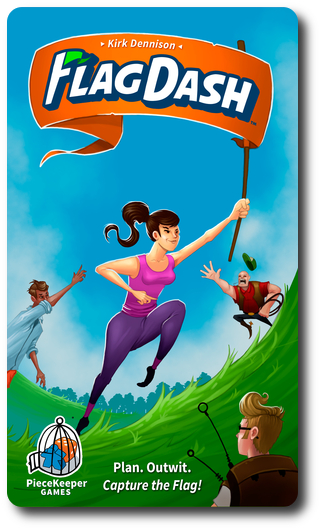
The Basics:
- For ages 8 and up (publisher suggests 10+)
- For 2 to 4 players
- Approximately 30 minutes to complete
Geek Skills:
- Active Listening & Communication
- Counting & Math
- Logical & Critical Decision Making
- Reading
- Strategy & Tactics
- Risk vs. Reward
- Visuospatial Skills
- Cooperative & Team Play
- Hand/Resource Management
- Bluffing and Misdirection
Learning Curve:
- Child – Easy
- Adult – Easy
Theme & Narrative:
- Capture the flag, one card at a time
Endorsements:
- Gamer Geek mixed!
- Parent Geek approved!
- Child Geek mixed!
Overview
To capture is to control. To control is to conquer. To conquer is to win. This is the goal of every player who attempts to capture the flag of their opponent. Working as a team, you must avoid being caught and grab the prize. The winner gets milk and cookies!
Flag Dash, designed by Kirk Dennison and to be published by PieceKeeper Games, will reportedly be comprised of 6 Character meeples, 6 Character cards, 12 Character flags, 2 Team flags, 12 Boost tokens, 6 Tunnel tokens, 6 Wall pieces, 6 Flag markers, 1 Tiebreaker marker, 28 Basic Action cards, 4 Special Action cards, 28 Priority tokens, 2 Spy tokens, 2 Cat tokens, 2 Trap tokens, , 4 screens, and 1 game board (double-sided). As this is a review of the prepublished game, I cannot comment on the game component quality.
Warm Up Exercises
To set up the game, first divide the players into two equal teams. One team will be “Red” and the other team will be “Purple”. Team members should sit next to each other and across from their opponents if possible.
Second, each team picks 2 Characters to use as “Runners” and 1 Character as their “Defender”. If playing with 4 players, each team only picks 2 “Runners”. Collect 1 Character card and matching meeple (meeple color will match the Character card color).
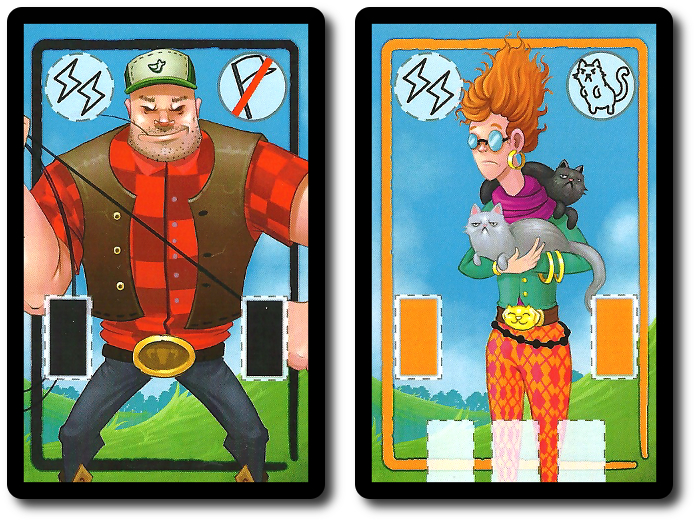
The icon found on the card’s upper right-hand corner indicates if it’s a “Runner” or a “Defender”
Third, place the game board between the two teams. Either side can be used.
Fourth, divide 2 Wall pieces and 4 Tunnel tokens between the two teams and add them to the game board to create obstacles.
Fifth, each team places their meeples on their side of the game board. Each side will have an illustrated divider (road or sidewalk) that splits the game board in half. Players must place their meeples on their half of the game board, but can place their meeple as close to the opponent’s side as they like without crossing over the line. Then place the Team flag using the same restrictions as the meeples.
Sixth, place the Character cards down on the team’s side and make sure the Character card side that represents the character’s role (“Runner” or “Defender”) is face-up. Place 2 Character flags on each Character card by color.
Seventh, give each player a screen and a complete set of 7 Priority tokens. These are placed behind the screen. Any screens and Priority tokens not used are returned to the game box.
Eighth, give each player a complete set of 7 Basic Action cards. All cards are the same, but players should keep their hand hidden from opponents.
Ninth, place the Boost and other tokens to one side of the game board, along with the currently unused Special Action cards. Give the Tiebreaker marker to the team with the youngest player.
That’s it for game set up. Time to capture the flag!
Flag Fury
Flag Dash is played in rounds and turns with no set number of rounds per game. A typical game round is summarized here.
Step 1: Plan Your Move
Each player selects 1 Basic Action card from their hand to play. This card represents the move their meeple will make on the game board. Players on the same team can discuss their moves if they like, but they should do it quietly and cannot leave the table. The selected Basic Action card is placed face-down in front of them. This is card represents the player’s first move. The player then takes 1 Priority token and places it face-down on top of the Basic Action card.
The Priority tokens are more than just numbers. The lowest number used will always start the round, giving the players an opportunity to act first. This means the higher the number, the less likely the player will have a chance to take their move without first being harassed by others or beaten to the objective. But there is a very good reason why a player might want to go later in the game. Other than waiting to see what opponents might do, the Priority tokens give players Boost tokens that allow players to move their meeples up to 2 additional spaces and even play more Basic Action cards. Most importantly, the “7” Priority tokens allows the player to collect all their previously used Priority tokens. Players need to plan carefully.
After completing the requirements for their first move, they repeat the same steps to select and prioritize their second move. The end result will be 2 face-down Basic Action cards with 1 Priority token face-down on each card.
Step 2: Reveal Priority Values
Each player now reveals their first move Priority token. The player with the lowest value is the first to take their action, followed by the next lowest, and so on. If there is a tied Priority token value, the tie goes to the team with the Tiebreaker marker. Any benefits provided by the Priority token should be noted.
Step 3: Reveal Actions
Starting with the first player and continuing in turn order sequence, the following takes place.
- Reveal Basic Action card
- Choose to move the player’s “Runner” or the team “Defender”
- Take the full action or not at all (no movement)
- Discard Priority token next to game board, face-up
The “Arrow” Basic Action cards point towards the opponent’s side of the game board, towards the player’s side of the game board, left, or right. These allow the player to move their selected meeples 1 space on the game board in the direction the “Arrow” card is pointing.
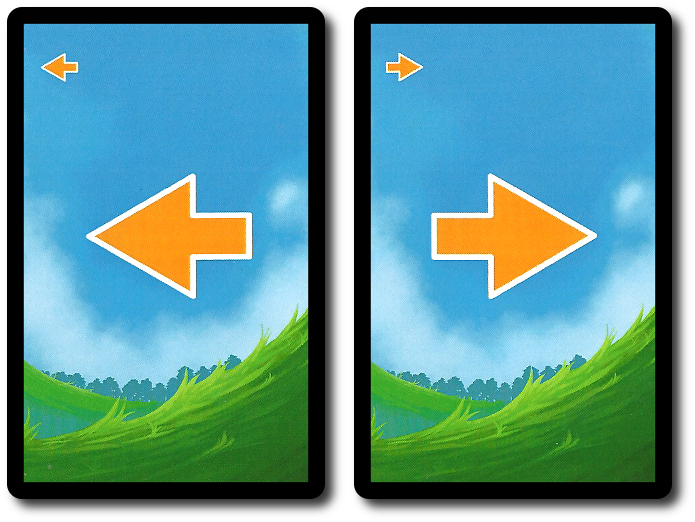
The “Flag” Basic Action card can only be used on a “Runner” and allows the player to complete one of the following on their turn.
- When the “Runner” meeple is 1 adjacent (not diagonal) space away from an opposing Team flag, the Team flag is picked up by the “Runner”. “Runners” can reach over walls and take flags away from other team mates.
- Pass the captured Team flag to another “Runner” or “Defender” meeple that is 1 adjacent (not diagonal) space away. Walls do not obstruct the pass and the player can leave the Team flag on an empty space if they like (essentially dropping it).
- Capture a Character flag from a meeple belonging to the other team that is 1 adjacent space (not diagonal) away. Walls block the grab. If the Character flag is successfully grabbed, it’s placed on the Character card.
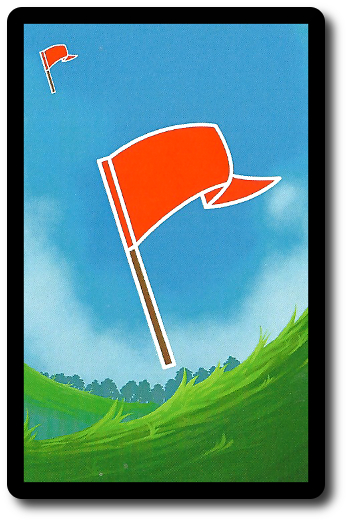
Note that the “Flag” Basic Action card cannot be used to capture the player’s Team flag. Players can only get their Team flag if it’s dropped by their opponents.
The “Push” Basic Action” card allows the player to move another meeple up to 2 orthogonal spaces in any direction. The player’s meeple must be 1 adjacent (not diagonal) space away. Players cannot push another meeple that is on the other side of a Wall piece. If the pushed meeple is holding a Team flag, it’s dropped in the space where the meeple is currently located and then the meeple is moved.
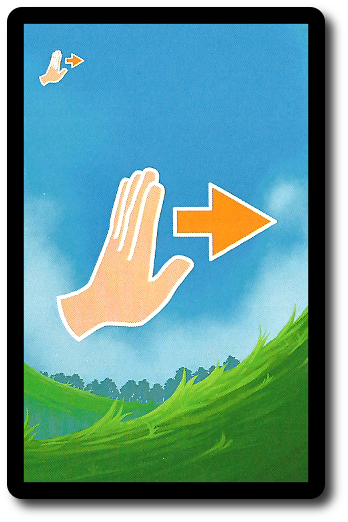
The “Copy” Basic Action duplicates the effects of any other Basic Action card played by the player this round.
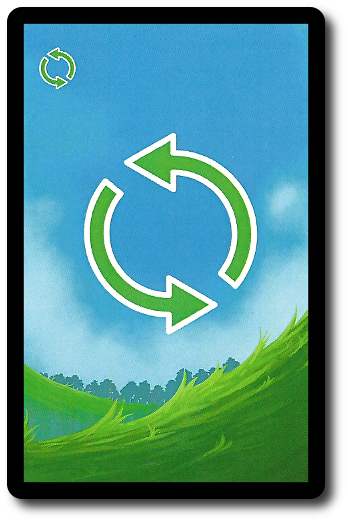
Step 4: Movement
The Basic Action card will determine what the movement or action will be. If the player moves a meeple, they can only move to 1 adjacent space and cannot move through other meeples, Team flags, or pass through Wall pieces. The one exception to pass through Wall pieces is if it has an arrow that indicates in which direction movement is possible.
Tunnel tokens indicate openings underground that connect to any other Tunnel token on the game board. These allow for fast-travel, of a sort, and the player’s meeple pops down 1 tunnel and appears at the mouth of another. Players can only use 1 tunnel per move and not at all if they are carrying a Team flag.
Step 5: Complete Second Move
The second move is now completed by first revealing the Priority token and determining the turn order.
Finishing the Round
The round is completed when all players finish their second move. The Basic Action cards are collected and placed back in the player’s hand, but not the Priority tokens. Used Priority tokens remain unavailable until the player uses their “7” Priority tokens to reclaim them.
Winning the Game
The game can end one of two different ways.
- The first team to capture and carry their opponent’s flag to their territory wins.
- The first “Runner” player to capture 1 Character flag from each opponents’ Character wins the game for their team.
Game Variants
A number of game variants are available for players who like to change how the game is normally played. Each are summarized here.
New Round? New Rules!
Players can optionally reset and add new rules after the end of each round. Examples include changing “Runner” and “Defender” assignments, and resetting meeple locations.
Flags for Two
Flag Dash can be played with as little as 2-players, with both players controlling more than 1 meeple or each player just using 1 meeple each. The playing area is reduced in size to keep the time spent on movement down and keep the focus on the flag stealing.
Flags for Three
With an odd number of players, two teams are created with the most skilled player taking on the two other players. The single-player takes on the role of 2 meeples.
Special Abilities
Character cards indicate what special ability the character has, but only when they are a “Runner”. Special abilities include placing traps, using lassoes, spying, jumping, digging, and even attacking with aggressive cats. Give the Special Ability cards that match the Character cards in play. Each special ability has unique rules that require their use in play to be subtly different.
Hide and Seek
During the placement of the meeples and flags, place a screen in between the two team areas to provide some secrecy. Both sides complete their placement as normal. When both teams are done, remove the screen and reveal the initial placement. Instead of 1 Team flag per team, 3 are used. Two of the three Team flags are decoys!
Bad Weather
This game variant uses the Basic Action cards to determine the current state of the weather. The weather can swing from gusty to downright deadly, forcing meeples to run for cover indoors to get out of dangerous thunderstorm.
Additional Customization
Beyond what is noted here, players can alter the rules as they like. For example, only allowing players a maximum of 1 Boost token rather than 2 or maybe a maximum of 3. Players can also set up the game board using any number of Wall pieces and Tunnel tokens right from the start. Players can even remove Basic Action cards and Priority tokens if they wanted to. The game can be made as easy or as difficult as the players like, truly making a game that is all their own.
To learn more about Flag Dash, visit the publisher’s website or visit the Kickstarter campaign.
Final Word
The Child Geeks were very familiar with the game Capture the Flag and were eager to play it on the kitchen table (a place they never thought possible). It soon became apparent that the game was not for everyone. According to one Child Geek, “I like how the game is played, but movement feels a bit slow at times.” Another Child Geek said, “It’s a good thing we can talk to our team member, otherwise this game would drive me crazy.” What the Child Geeks liked the most was the goal of the game itself. They really enjoyed trying to outwit and out maneuver each other. What they liked the least was the Priority tokens, as many felt it limited their ability to play and reduced the fun. The Child Geeks’ final vote resulted in a mixed endorsement.
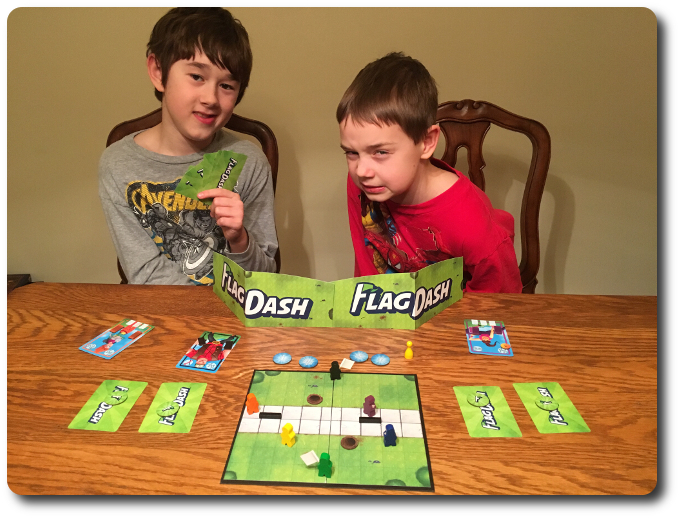
Well…this doesn’t look good…
The Parent Geeks enjoyed themselves, finding the alternative Sports game to be a little bit like Chess, a little bit like Tag, and a whole lot like Capture the Flag. According to one Parent Geek, “I have always enjoyed games that are about trying to figure out what the opponent may or may not do and then setting it up. When you reveal the play, it feels great or really horrible. Either way, it’s fun.” Another Parent Geek said, “I found the rules to be a bit clunky at first, but the game moves at a brisk pace once you and your teammate get the hang of it.” When all the votes were in, the Parent Geeks fully approved the game, finding it to be fun with their peers and with their family.
Every once in a while, the Child Geeks and the Gamer Geeks agree with each other. This is one of those cases. Like the Child Geeks, the Gamer Geeks liked the game’s concept and many of the small details that make up the game’s overall experience. They also didn’t like some of the restrictions. According to one Gamer Geek, “The game feels a bit constrained at times and the movement can be horrible if you don’t have Boost tokens around.” Another Gamer Geek said, “I like the game play and the decisions to be made. The game feels very tactical and strategic. The only aspect of the game I don’t like is the movement which feels forced and restrained at the same time.” When the games were over, the Gamer Geeks gave Flag Dash a mixed level of approval.
The game forces upon the players some interesting decisions. For example, should a team send both their “Runners” across the line to get the opposite team’s flag? If they do so, they can use 2 “Runners”, but that leaves their own flag guarded by only their “Defender”. Or perhaps they should only send 1 “Runner”, leaving the second to help defend? A good idea, but only 1 “Runner” can easily be blocked. How the game is being played by the opposite team will ultimately be the biggest influence, persuading the players to take an offensive or defensive position.
And that is a lot of fun to work through, if you are the kind of player who likes to think tactically and come up with a strategic approach to victory. Or, like many players, simply just do what you think feels right and go for the flag. Both approaches work and both types of players should feel satisfied with the amount of information and freedom they have to act upon.
I believe some of the grumbling we observed about the game in regards to movement has nothing to do with the player’s ability to move. A player certainly can. In fact, they can turn on a dime and get wherever they want to go. They just can’t do so quickly and they must wait their turn. The Priority tokens added a level of strategic and tactical play that felt out-of-place for many of our players, but it must be said that this same type of game play is what made Flag Dash so much fun for others. While some saw the rules as a restraint, some also saw them as adding a unique and enjoyable challenge.
As for the Special Actions, they are interesting, but not all that rememberable. The real game is about working together and out thinking the opposition. The Special Abilities are a unique way to interact with the game and a new approach to tackling obstacles. I personally liked playing without them, but there were many of our players who enjoyed them, too. Their use is going to depend on personal preference. Players will spend more time digging holes and customizing the playing area. I guarantee it.
If you enjoy games where the goal is always the same, but the means to reach the goal are always changing, then do take the time to seek out Flag Dash. The game combines deduction, timing, tactics, strategy, and cooperation that works very well and keeps everyone engaged. Even when it isn’t your turn, you still want to be part of the action. If this all sounds good to you, go capture an opportunity to play this game.
This is a paid for review of the game’s final prototype. Although our time and focus was financially compensated, our words are our own. We’d need at least 10 million dollars before we started saying what other people wanted. Such is the statuesque and legendary integrity of Father Geek which cannot be bought except by those who own their own private islands and small countries.



